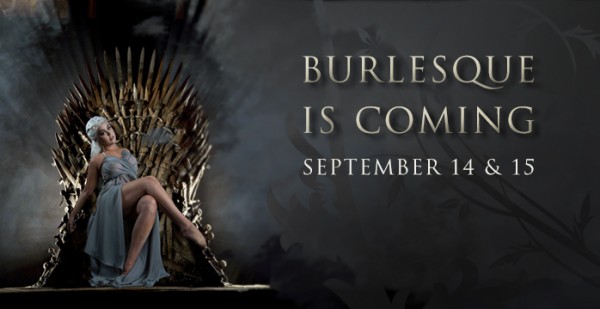
Hello again from Ogre Jenni!
A Virginia-based burlesque company, Blacklist Burlesque, will perform at Santa Fe’s hometown theater, the Jean Cocteau Cinema, on Monday, September 14th and Tuesday, September 15th. Blacklist Burlesque promises a hilarious and sexy parody of George R.R. Martin’s Game of Thrones series. View the specific times and purchase tickets here: http://bit.ly/1Kggk3a
Here are some silly quotes from Blacklist Burlesque:
“For the night is dark and full of rhinestones.”
“Arya gonna come see us? Aw, c’mon, you gotta have a Sansa humor!”
Blacklist Burlesque refers to themselves as the "first name and last word in Richmond, Virginia and beyond for neo-burlesque and nerd-lesque shows." They already had me at "Burlesque," but they won my tiny black heart with "nerd-lesque."
Holy fishnets, Batman! I did not know that “nerd-lesque” was even a thing until we booked Blacklist Burlesque’s Game of Thrones-themed act at the Cocteau. Apparently, in the world of nerd-lesque, there are Star Trek cabarets, super hero acts, high fantasty burlesque shows, and—quite frighteningly—Cthulhu strip-teases. There are just some things in this universe that the human mind shouldn’t be exposed to. Or maybe I should just get out of my lair every once in a while.
For those who don’t know the basic history of burlesque, it is an art form that has thumbed its nose at upper-class cultures and social conventions for hundreds of years. In the 17th and 18th centuries, the umbrella term “burlesque” covered many varieties of theatrical lampooning or “travesty.” In the 19th century, burlesque producers and performers would take specific arias and oratorios from famous operas, and rewrite the lyrics for comedic effect—just like “Weird Al” Yankovic! In other words, the middle and lower classes got to knock “serious” art off of its pedestal from time to time.
But what about the strip-tease, the feather costumes, and the pasties, you ask? Strip-tease, an important aspect of modern and neo-burlesque, became standard around the 1930s. Think of the bawdy cabaret culture of the 1930s—and then the pin-up girls of the 1940s and 1950s. Now this is just a brief overview from a humble ogre, so if any of you readers have any interesting or tantalizing tidbits to add about burlesque, please leave a comment—and see you at the show!





